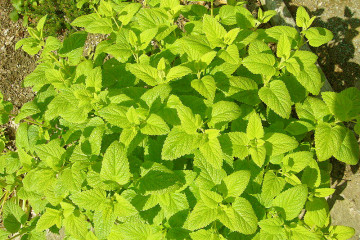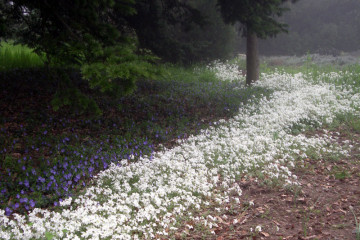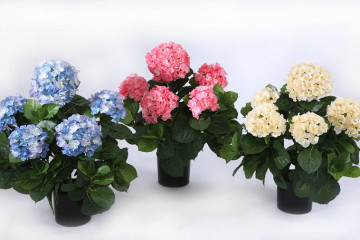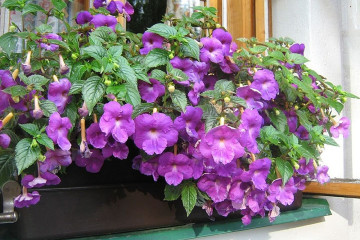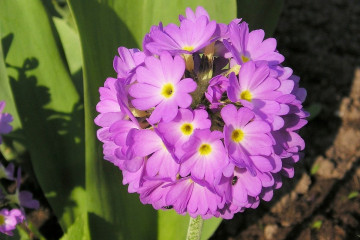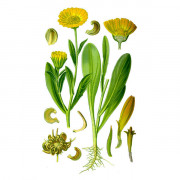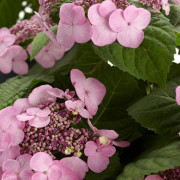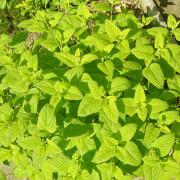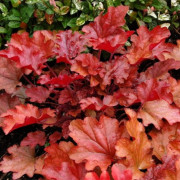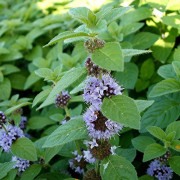Everything about poppy: what it looks like, is it possible to grow it in the country
Content:
- What does a perennial decorative poppy look like?
- Classification of popular perennial poppy species
- Perennial poppy cultivars that are most popular with gardeners
- Popular types of annual poppies
- How perennial poppies breed
- Features of care in the garden
- When and how it blooms
- Possible growing problems
- Use in landscape design
Poppy is an unpretentious flower. He loves the sun and loose, light soil. The plant is undemanding to the composition of the soil, but if the land intended for poppies is properly fertilized, the gardener will be able to admire large flowers that resemble bright flashes of flame throughout the summer.
What does a perennial decorative poppy look like?
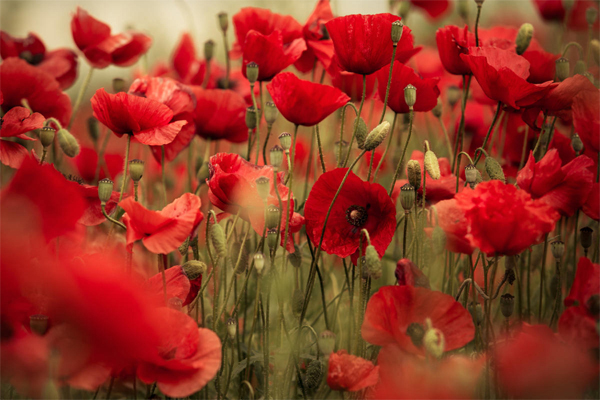
Poppy flowers resemble bright flashes of fire
Poppy is a plant with large, straight shoots (pubescent and naked), pinnately dissected and whole foliage, rod-type root system. The leaves have a small hairy-bristly edge. The flowers are regular in shape, with many thin stamens, located on the peduncles of an oblong shape.
Flower buds are usually solitary, but in very rare cases they can be collected in paniculate inflorescences. The petals, in most cases, are colored orange, pink, white, red, yellow. The club-shaped fruit contains many seeds. At the end of the ripening period, the seed capsule opens and the seeds fly in different directions, far from the flower.
What family does it belong to
Decorative perennial poppies (genus Papaver) belong to the Poppy family. The homeland of the plant is considered to be Southern and Central Europe, Asia and Australia. In the wild, the field poppy takes root well in places with a cold, subtropical and temperate climate. Gardeners look at it not only as a decoration of the estate, but also as a medicinal plant.
Briefly about the history of appearance
The first mentions of poppy are found in the history of Ancient Greece. The ancient Romans, Babylonians and Egyptians considered it a garden flower and was grown as a remedy for evil spirits and a symbol of fertility. The seeds of the plant were used as a sleeping pill, and the brides' shoes were filled with petals and used for fortune telling. A description of this culture is found in ancient treatises on the Persian Paradise and the biblical Eden.
Plant characteristics
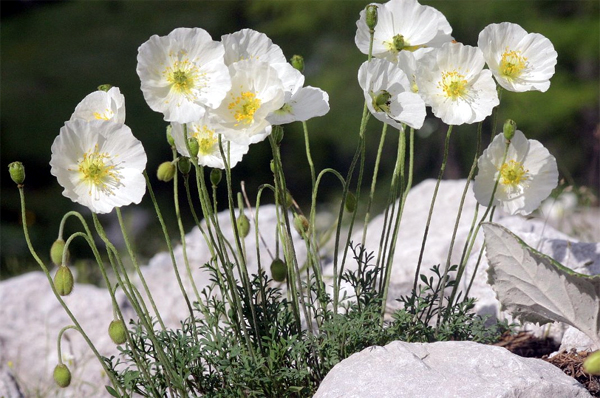
Blooming decorative poppies
The flowering period begins in April, May or June. Some crops ripen in July, some varieties bear fruit in August. Large flowers of ornamental poppies contain large amounts of pollen.Another sign of decorativeness is the rapid shedding of petals. Opening early in the morning, they fall off in the evening.
An elongated box with jagged edges and many small seeds inside is formed on a faded flower. If the owner's plans include collecting seeds, the boxes are not touched, they are left to ripen.
Ornamental poppy seeds are very small and for this reason they are sown, after mixing with river sand in a ratio of 1: 5. This trick is rarely justified and the seeds that have hatched have to be thinned out. The distance between seedlings should be at least 5 cm. When thinning poppies a second time, gardeners increase the distance to 20-25 cm. Ignoring this stage leads to the fact that the plants grow too long and frail.
The petals of the plant are rich in vegetable fats (no more than 44%), organic acids, glycosides and flavonoids.
Benefit and harm
Physicians who lived almost 4 centuries ago spoke about the beneficial properties of poppy. In folk medicine, certain parts of the plant are used as a sleeping pill, anesthetic, anti-inflammatory and expectorant. In ancient times, a decoction from it destroyed warts, cured fever and swelling of the joints. Poppy seeds are still used for the preparation of confectionery and dressings. Poppy flowers contain vitamin C.
Milky secretions from unripe capsules have long been considered a particularly valuable product. This kind of juice is used for the preparation of pain relievers and cough medicines.
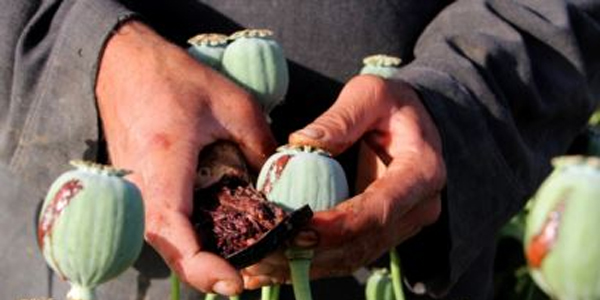
Collecting poppy pods
The genus Papaver is more than a hundred species of poppy, and some of them are dangerous to humans due to the high content of psychotropic and narcotic substances. Poppy is widely recognized as a source of opium, morphine, codeine and papaverine. The first two components are classified as narcotic drugs that cause persistent addiction. In medicine, it is forbidden to prescribe opium and morphine to patients suffering from acid starvation of the blood, who are on the cure of pulmonary emphysema, bronchial and liver diseases, from alcohol and drug addiction.
Classification of popular perennial poppy species
Poppy is one of the brightest colors. More recently, it served as a decoration for gardens, vegetable gardens and fields. The flowering period begins in the early days of summer. Today, most gardeners do not dare to plant them on their plots, fearing to attract the attention of drug addicted patients. Only some species containing minimal amounts of narcotic substances are actively cultivated. All poppies do not tolerate frequent transplants.
Oriental poppy, perennial or Turkish (Papaver orientale)
Tall (up to 90 cm) perennial. It reaches a meter in diameter. The foliage is beautiful, pinnately dissected, coarse-haired. During the flowering period, it is covered with single, large double, semi-double and simple flowers. It can be distinguished from other poppies by large black spots in the inner part of flowers and stamens with the same coloring. Different types of oriental poppy may differ in the shape and color of the flowers.
In May, a rosette of leaves is formed, and in June-July - flowers. In August, the foliage dries up, and after the end of the flowering period, a small box forms in place of the flower. By September, the foliage rosette can form again, and in some cases the flowering period is repeated, but full-fledged flowers rarely appear.
Alpine (Papaver alpinum)
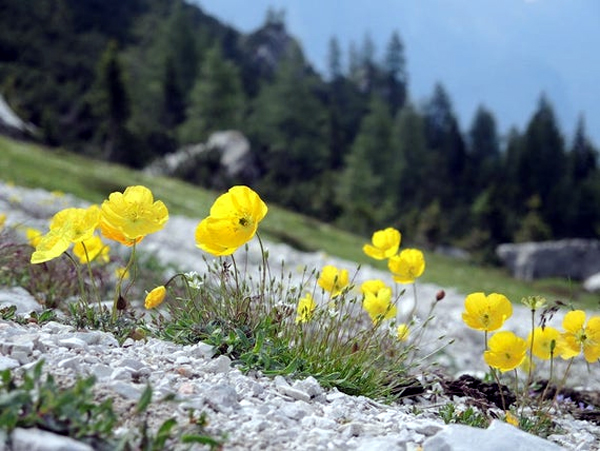
Alpine poppy variety
The smallest and most short-lived perennial, renewing by self-seeding. The maximum height to which the alpine poppy can grow is 30 cm. It blooms earlier than other poppies - in May-June. The maximum lifespan of one plant is 3 years. It blooms mainly with white and yellow flowers, the diameter of which can reach 5 cm. It takes root well in rock gardens.
Holostem poppy (Papaver nudicaule) or saffron poppy (Papaver croceum)
A short-lived perennial (maximum life span is 3 years), which reproduces well by self-seeding. The bluish foliage of the plant is collected in an outlet. The maximum height of the peduncles is 30 cm, the diameter of the flowers is 5 cm. It blooms in white, yellow, orange from May to September.
Rockbreaker (Papaver rupifragum) or Spanish Poppy (Spanish Poppy)
A perennial plant, widely known among flower growers due to its long flowering period (blooms all summer) and dense silvery foliage. Needs regular removal of dried inflorescences. Blossoms most abundantly in June.
Perennial poppy cultivars that are most popular with gardeners
Garden poppy is an ornamental plant and is very beloved by flower growers. It is often used to decorate summer cottages and park areas.
Beauty Queen
During the flowering period, it is abundantly covered with saucer-shaped flowers of a light orange hue. The maximum height of the peduncle is 90 cm.
Black & White
The flowers are spectacular, corrugated, white, large in size. The core is black.
Blue Moon
The height of an adult bush is almost 100 cm. It blooms with large pink flowers. The petals are slightly cast with a bluish-gray tint, at the base of the inflorescence there is a black spot.
Cedric Morris
Blossoms in large, delicate purple flowers with a black spot in the middle. Corrugated petals. The approximate height of the peduncles is 80 cm.
Curlilok
During the flowering period, it is covered with orange, slightly drooping flowers. There is a black spot at the base of the petals with a serrated edge. Peduncles grow up to 70 cm.
Allegro
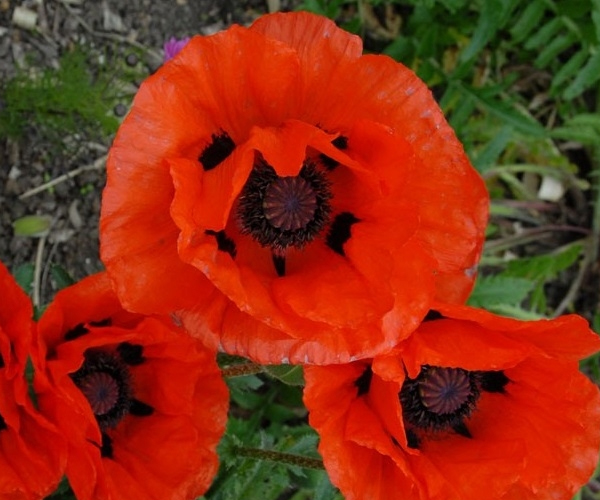
Poppy oriental Allegro
Blossoms with orange-red flowers collected in rosettes. Peduncles can grow to a height of 70 cm.
Garden Glory
One of the most decorative oriental poppy varieties. It is known for its pale pink flowers with a dark core. Corrugated petals, terry. The maximum height of the peduncles is 80 cm.
Mrs Perry
During the flowering period, it is covered with medium-sized pink flowers, in the central part of which there is a black speck. The height of the peduncles is about 90 cm.
Pettis Plum
Blooms in May. Plum flowers. The maximum height of the peduncles is 70 cm.
Karin
With the onset of the flowering period, it is covered with salmon-pinkish, small saucer flowers. They are located near the leaf outlet. Peduncles grow to a height of 60 cm.
Popskyle
It is a bush up to 25 cm high with powerful, stable peduncles. Bright flowers reach 10 cm in diameter.
Cardinal
Holostebel poppy variety. A bushy plant up to 40 cm high.The variety owes its name to scarlet flowers, which at the height of the flowering period reach 6 cm in diameter.
Sulfureum
Bush up to 30 cm high.Diameter of bright lemon flowers is about 6 cm.
Atlant
A low-growing bush that grows to a mark of 20 cm. The diameter of the flowers is 5 cm. It blooms with white and yellow flowers.
Roseum
During the flowering period, bushes 40 cm high are covered with pale pink flowers with a diameter of about 6 cm.
Popular types of annual poppies
Annual poppies are not afraid of cold weather, so many gardeners sow them in late autumn or early spring. Seedlings appear 10-15 days after sowing seeds in open ground.Seeds harvested after the end of the flowering period can be stored for up to 4 years without losing germination.
Sleeping poppy (Papaver somniferum), or opium poppy
Flowers, reaching a diameter of 9-10 cm, can be colored, depending on the variety, in lilac, pink, purple, white, lilac or red. Some specimens have black or white spots at the base.
Hybrid (Papaver hybridum)

Hybrid poppy cultivar
It reaches a height of 30 cm. During the flowering period, it is covered with rare, dark red 4-leafed flowers with a black core.
Self-seeding poppy (Papaver rhoeas)
It grows to a height of 60 cm. The root foliage is serrated, pinnately divided. Stem foliage is tripartite, with pinnately dissected lobes. Both the foliage and the stem of the plant are coarse-haired. During the flowering period (from June to September), it is covered with simple or double flowers with a diameter of 5-7 cm, pink, purple, salmon or white. Some varieties have a dark spot at the base of the petals.
The tallest annuals include the peony poppy. Some species are up to one meter high.
How perennial poppies breed
The key to a lush and long-lasting flowering of decorative perennial poppy is competent planting and care. A perennial can grow in one place for 10 or more years, but experienced gardeners transplant it once every 5-7 years. The plant can be propagated by seeds, seedlings and dividing the bushes.
Growing from seeds
One of the most popular plant propagation methods. In order for the seed to scatter on its own, growers leave fruit-boxes on the faded plants. Self-seeding will occur next year. Most gardeners prefer to harvest and sow seeds by hand.
Seeds are scattered over a previously dug area and slightly crushed with loose earth. If the seed is buried too deep in the soil, it will not have enough strength to germinate.
Time to board
The crop can be sown in spring and autumn. Autumn sowing is carried out in previously prepared soil. Stratification is useful for seeds, therefore, in regions with a mild climate, it is advisable to carry out work in the fall. Spring sowing in open ground is carried out early, before the onset of stable heat.
Planting adult perennials is best done in May or September, before or after the flowering period.
Capacity selection

Germinating poppy seeds
Seeds do not need to be sown directly in open ground. In early spring, they can be germinated in a plastic tray, a peat cup or a special “tablet” filled with a nutrient substrate. The seeds are scattered over the surface of the soil, slightly pressed into the ground and covered with polyethylene. When the seedlings will sprout, and this will happen in 14-15 days, they will need coolness and good lighting.
Soil and seed preparation
For sowing, both neutral and slightly acidic soil are suitable. It is desirable that the soil be light and crumbly, loamy or sandy loam. Having matured, the flower will be able to thrive in any soil.
A culture can do without watering for a long time, but a lack of moisture will certainly affect the quality of flowering. With abundant watering, stagnant water can spoil the root system of the plant.
The soil intended for planting must be fertilized with humus at the rate of 5-10 kg per square meter. You will also need fertilizing with minerals. Each square meter of land requires 30-50 g of fertilizer. They dig up the fed soil by immersing the shovel into the ground to a depth of 30–40 cm.
Sowing all types of poppy seeds requires compliance with the following rules:
- prevent stagnation of water;
- do not plant seeds in places with a close occurrence of groundwater.
Seedling care
The beds with hatched seedlings are fed 1-2 times during the season. The soil in which the poppies are planted must be regularly loosened (with the simultaneous removal of weeds), providing air flow to the rhizomes, and mulched (preferably with peat).
Dive and transfer
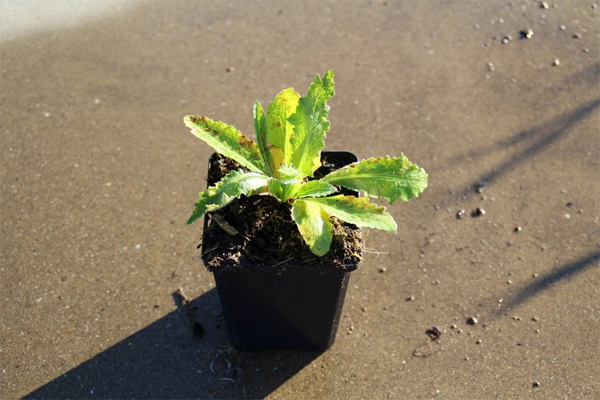
Poppy seedling
After the formation of the 2nd true leaf, the seedlings dive, trying not to damage its parts. The plant does not like transplants and will die if handled carelessly.
Landing on a permanent place is carried out after the appearance of the 5th leaf. The culture is dug up together with an earthen lump and carefully transferred to a new place.
Dividing the bush
The bush is dug up together with a lump of earth and divided into several parts. Given the fragility of the rhizome, this work must be done very carefully. Parts of the flower are immediately transplanted into pre-prepared holes. The permissible distance between the two nearest holes is 50–70 cm.
Features of care in the garden
The tops of large specimens at the beginning of the flowering period will be weighted with buds, so they need support. For tying poppies, it is recommended to use wide ribbons made of natural fabrics, since thin or nylon ropes can easily damage the stem.
After the end of the flowering period, dead parts are cut off at ground level. Seeds are harvested after the fruits have ripened.
Young plants need special care - they need to be watered frequently. The divided bushes should spend the first winter under cover of dry leaves and spruce branches. In the future, plants will be able to hibernate without shelter.
Poppy can withstand frosts down to -40 ° C. Adult bushes do not require additional shelter for the winter, but the safety of rare varieties should be taken care of, they should be covered with dry leaves for the winter.
What conditions do poppies like
Perennials such as oriental poppy prefer loose, sandy loam soil in which water does not stagnate. If the soil is devoid of nutrients, and its acidity is increased, the flowers will become smaller every year. The most suitable place for disembarkation is areas flooded with sunlight. In the shade, the plant will also not disappear, but the buds will be worse to tie.
What is the plant afraid of
In general, poppy is an unpretentious plant, but in order to achieve abundant and long-term flowering, the gardener must water the beds in time, trying not to flood them. The plant is afraid of both prolonged drought and stagnant water.
Watering
It can do without watering for a long time, but the lack of moisture affects the quality of flowering. With abundant watering, stagnant water can spoil the root system of the plant.
Mulching

Poppy in the garden
The land in which the poppies grow is mulched with peat, but in the absence of such, you can take any mulch. Mulching relieves the grower of the need to regularly water the beds and get rid of weeds.
Loosening
Loosening must be carried out before sowing the poppy and in the process of caring for adult flowers. The earth is loosened to a depth of 3 cm.
Top dressing
Fertilizing is humus and minerals. The first is scattered over the land in such a way that 10 kg of fertilizer are used for each square meter. Mineral substances are distributed in such a way that at least 30 g is needed per 1 square meter.
Transfer
The flower is transplanted carefully so as not to damage the root system. They dug out together with a lump of "native" earth and immediately transplanted to a new place. The recommended minimum distance between two nearest plants is 50 cm. It takes root well in places where large-leaved hydrangea (hydrangea macrophylla) was previously grown.
When and how it blooms
Most poppies bloom throughout the summer months.
Types of flowers
Many experienced gardeners and amateurs plant the following species on their plots:
- Oriental;
- holosteel.
Flower shapes
Oriental red poppies have 4–6 petals of an almost rounded shape. The length of the petal is about 9 cm. Their color varies from orange-fiery red to pink-red. There may be a black, almost square spot at the base of the petals. The stamens are dark, slightly widened at the top, and the anthers are oblong, purple in color.
Holostem poppy flowers can be colored yellow, orange, and sometimes white. The diameter of obovate, simple or double petals reaches 6 cm.
Flowering period
The flowering time of the oriental poppy is June – July. Holostem poppy blooms in May and blooms until autumn.
Changes in care during flowering
Caring for flowering plants is reduced to moderate watering and removing weeds (in the absence of mulch).
Possible growing problems
Poppies are not capable of fighting some infectious diseases and garden pests. For preventive purposes, plants are irrigated with preparations containing copper: Bordeaux mixture, copper sulfate (copper sulfate), contact fungicide (Maxim), systemic fungicide (Topaz). Prevention is carried out before the flowering period.
Pests
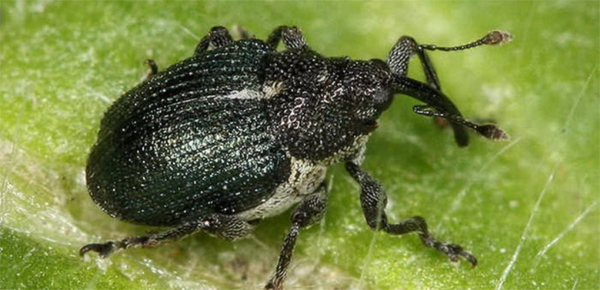
Poppy lurker
Poppy lurkers and other beetles from the weevil family like to settle in the root system and on poppy leaves. It is extremely difficult to detect them - having felt the approach of a person, insects fall to the ground, merging with lumps of soil. Gardeners recognize their presence by external signs: the affected plant stops growing, and its lower foliage turns yellow and dies.
Pest control consists in spraying with 0.2-0.35% chlorophos: 2-3 treatments are enough with an interval of 10 days.
Diseases
Crops cannot withstand the formation of powdery mildew and fungal black spot.
Signs of improper care
Before or after sowing seeds, the soil must be treated with insecticides. If this is not done, pest beetles can settle in the root system and on the lower foliage. Soil treatment with 7% chlorophos or 1.6% phosphamide on granular superphosphate (10 g per square meter) can be carried out after the seeds have sprout.
Poppies planted in a too shaded part of the garden practically do not bloom due to the slow setting of a flower bud. Lack of flowers can be a sign of improper care: although plants are considered unpretentious, they periodically need watering, weeding and mulching.
Use in landscape design
Designers use poppies to decorate green lawns and flower beds. They get along well with decorative cereals, delphinium, Chinese chrysanthemums, cuffs, geraniums, cinquefoil, milkweed, all liliaceae, cosmea, tobacco and lavater.
Many amateur gardeners are concerned about the question: is it possible to grow poppy in the country? The law prohibits the widespread cultivation of sleeping poppy (Papaver somniferum), oriental poppy (Papaver orientale), bracts poppy (Papaver bracteatum) and bristle poppy (Papaver setigerum). Experts do not recommend gardeners to cultivate all types of poppies with too large seed pods - they are the ones that pose the greatest danger.

